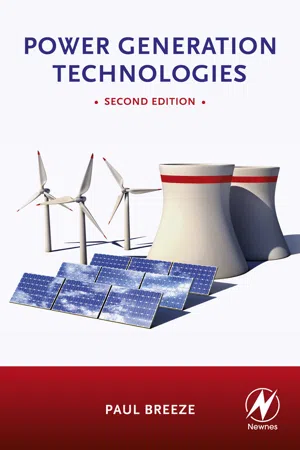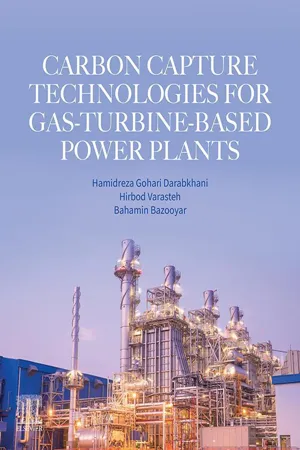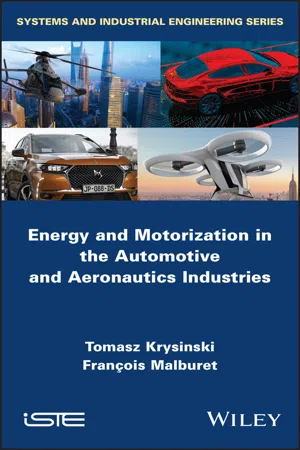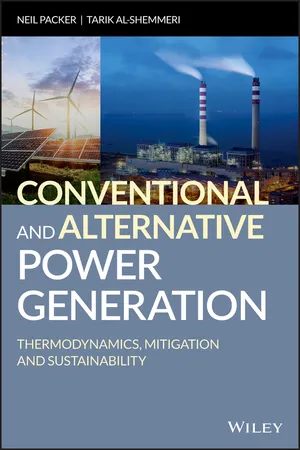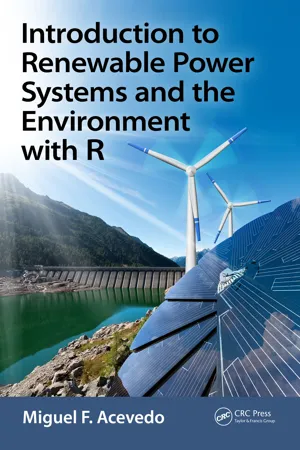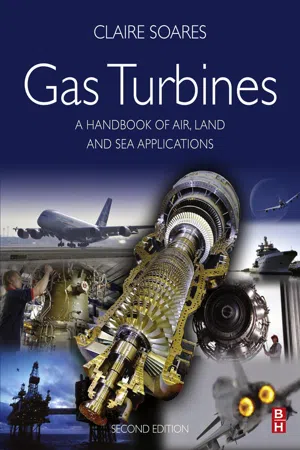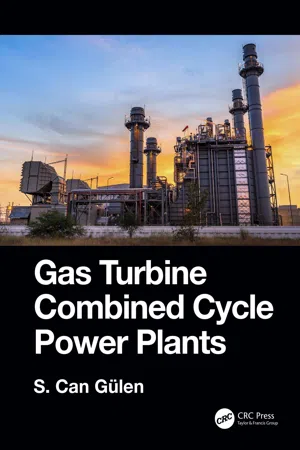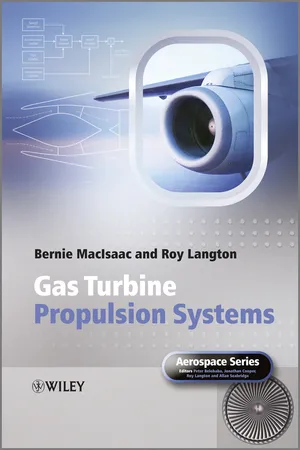Technology & Engineering
Gas Turbine
A gas turbine is a type of internal combustion engine that converts natural gas or liquid fuel into mechanical energy. It operates on the principle of continuous combustion, where air is compressed and mixed with fuel to generate high-speed, high-temperature gas flow. This flow then drives a turbine to produce power for various applications, such as electricity generation and aircraft propulsion.
Written by Perlego with AI-assistance
Related key terms
1 of 4
Related key terms
1 of 3
12 Key excerpts on "Gas Turbine"
- eBook - ePub
- Paul Breeze(Author)
- 2019(Publication Date)
- Newnes(Publisher)
To cater for the growing power generation market, the main manufacturers – and there are only a limited number of these because the Gas Turbine is a very specialised high-technology machine – began quickly to build bigger and more efficient engines. Today, single engines of up to 400 MW in capacity are available. Most of these are aimed at the combined cycle market and have efficiencies on their own of between 38% and 42%. However, when used in a modern integrated combined cycle plant the latter should be capable of around 60% efficiency.The Gas Turbine Principle
A Gas Turbine is a machine which harnesses the energy contained within a gas – either the kinetic energy of motion of a flowing gas stream or the potential energy of a gas under pressure – to generate rotary motion. In the case of a Gas Turbine, this gas is usually, though not necessarily, air. The earliest man-made device of this type for harnessing the energy in moving air was a windmill described by Hero of Alexandria in the 1st century AD.This earliest known machine was a near relative of today’s wind turbine which, though clearly a type of Gas Turbine, is far removed from the modern Gas Turbine concept. Closer in concept to the Gas Turbine was the smokejack, developed in the middle of the second millennium AD. As described in the 17th century by John Wilkins, Bishop of Chester, the smokejack used hot air rising through a chimney to move windmill vanes within that chimney and drive a shaft which could be used to rotate a spit for roasting meat.This principle of harnessing moving air within an enclosed chamber to create rotary motion for driving machinery was developed further during the industrial revolution. Following this principle, the 19th century saw a number of predecessors to the Gas Turbine. These used some form of compressor to generate a man-made flow of pressurised air which was fed into an enclosed turbine. In these machines the compressor was usually separate from the turbine.The direct ancestor of the modern Gas Turbine was first outlined in a patent granted to German engineer F. Stolze in 1872. In Stolze’s design, as in that of all modern Gas Turbines, an axial compressor was used to generate a flow of pressurised air. This air was then mixed with fuel and ignited, creating a very energetic flow of hot, high-pressure gas which was fed into a turbine. Crucially, the compressor and the turbine were mounted on the same shaft. A schematic of this arrangement is shown in Figure 4.1 - eBook - ePub
- Paul Breeze(Author)
- 2014(Publication Date)
- Newnes(Publisher)
To cater for the growing power generation market, the main manufacturers—and there are only a limited number of these because the Gas Turbine is a very specialized high-technology machine—quickly began to build bigger and more efficient engines. Today, single engines of up to 400 MW in capacity are available. Most of these are aimed at the combined cycle market and have efficiencies on their own between 38% and 42%. However, when used in a modern integrated combined cycle plant the latter should be capable of around 60% efficiency.Gas Turbine principle
A Gas Turbine is a machine that harnesses the energy contained within a gas—either the kinetic energy of motion of a flowing gas stream or the potential energy of a gas under pressure—to generate rotary motion. In the case of a Gas Turbine this gas is usually, though not necessarily, air. The earliest human-made device of this type for harnessing the energy in moving air was a windmill described by Hero of Alexandria in the 1st century AD.This earliest known windmill was a near relative of today’s wind turbine, which though clearly a type of Gas Turbine, is far removed from the modern Gas Turbine concept. Closer in concept to the Gas Turbine was the smokejack, developed in the middle of the 2nd century AD. As described in the 17th century by John Wilkins, Bishop of Chester, the smokejack used hot air rising through a chimney to move windmill vanes within that chimney and drive a shaft that could be used to rotate a spit for roasting meat.This principle of harnessing moving air within an enclosed chamber to create rotary motion for driving machinery was developed further during the industrial revolution. Following this principle, the 19th century saw a number of predecessors to the Gas Turbine. These used some form of compressor to generate a human-made flow of pressurized air that was fed into an enclosed turbine. In these machines the compressor was usually separate from the turbine.The direct ancestor of the modern Gas Turbine was first outlined in a patent granted to German engineer F. Stolze in 1872. In Stolze’s design, as in that of all modern Gas Turbines, an axial compressor was used to generate a flow of pressurized air. This air was then mixed with fuel and ignited, creating a very energetic flow of hot, high-pressure gas that was fed into a turbine. Crucially, the compressor and the turbine were mounted on the same shaft (Figure 4.1 - eBook - ePub
- D. Yogi Goswami, Frank Kreith, D. Yogi Goswami, Frank Kreith(Authors)
- 2017(Publication Date)
- CRC Press(Publisher)
10Gas Turbines
Richard H. Bunce CONTENTS 10.1 Overview 10.2 History 10.3 Fuels and Firing 10.4 Efficiency 10.5 Gas Turbine Cycles 10.6 Cycle Configurations 10.7 Components Used in Complex Cycles 10.8 Upper Temperature Limit 10.9 Materials 10.10 Combustion 10.11 Mechanical Product Features Defining Terms10.1 Overview
Gas Turbines are steady-flow power machines in which a gas (usually air) is compressed, heated, and expanded for the purpose of generating power. The term turbine is the component that delivers power from the gas as it expands; it is also called an expander . The term Gas Turbine refers to a complete power machine. The term Gas Turbine is often shortened to simply turbine, which can lead to confusion with the term for an expander.The basic thermodynamic cycle on which the Gas Turbine is based is known as the Brayton cycle. Gas Turbines may deliver their power in the form of torque or one of several manifestations of pneumatic power, such as the thrust produced by the high-velocity jet of an aircraft propulsion Gas Turbine engine. Gas Turbines vary in size from large, 775,000 hp utility machines, to small, 5 hp automobile and motorcycle turbochargers and microturbines. Now, 25–250 kW, recuperated Gas Turbines are being sold.Gas Turbines are used in electric power generation, propulsion, and compressor and pump drives. The most efficient power generation systems in commercial service are Gas Turbine combined-cycle plants with net power-to-fuel energy efficiencies of more than 60% (lower heating value [LHV] basis). Simple-cycle plants used in electric power generation have achieved efficiencies of over 40% (LHV basis).10.2 History
The fourth quarter of the nineteenth century was one of great innovation in power machinery. Along with the spark-ignited gasoline engine, the compression-ignited diesel engine, and the steam turbine, engineers applied their skills to several hot-air engines. Charles Curtis received the first U.S. patent for a complete Gas Turbine on June 24, 1895. Jens William Aegidius Elling designed and built the first Gas Turbine in Norway in 1903, which produced 11 hp. - Hamidreza Gohari Darabkhani, Hirbod Varasteh, Bahamin Bazooyar(Authors)
- 2022(Publication Date)
- Elsevier(Publisher)
Horlock and Bathie, 2004 ). Gas Turbine material technologies have been developed during the last 20 years. The cooling method of the blade and new coating materials let the turbines work at higher temperature, such as the NetPower cycle and CES cycle; in recent years, the development of composer pressure ratio support has increased turbine efficiency up to 60%.Gas Turbines convert the chemical energy of the fuel into either mechanical energy or kinetic energy. There are two types of Gas Turbines: (1) power generation Gas Turbines that convert the chemical energy of the fuel to shaft power to produce electricity and (2) Gas Turbines for aircraft which produce thrust for propulsion (Schobeiri and Meinhard, 2018 ).The main concept of Gas Turbine thermodynamics is receiving fuel energy at a high temperature at the combustor (C) to produce work at the Gas Turbine (A) and release the remaining energy to heat sink with the low temperature at the condenser (D), as shown in Fig. 1.3 .Figure 1.3 Typical Gas Turbine cycle.The power plants need to produce a network with minimum fuel consumption. However, the capital cost and operational cost need to be balanced to produce electricity with a lower cost (cost/kW h−1 ) (Horlock and Bathie, 2004 ). In recent years, new Gas Turbine technologies have been developed to reduce greenhouse gas emissions. To this end, the combustor section of these turbine are designed to work with renewable fuels including biogas (Bazooyar and Darabkhani, 2021 ), hydrogen (Bazooyar and Darabkhani, 2019 ) etc.1.3 Categories of Gas Turbines
There are seven categories for the simple cycle Gas Turbines as below:- 1. Heavy duty Gas Turbines
- eBook - ePub
- Don M. Pirro, Martin Webster, Ekkehard Daschner(Authors)
- 2017(Publication Date)
- CRC Press(Publisher)
13 Stationary Gas TurbinesThere are three commercially important types of prime movers that provide mechanical power for industry: the steam turbine, the reciprocating piston engine, and the Gas Turbine. All types achieve their result by converting heat into mechanical energy; any machine that does this (uses chemical reactions to supply thermal energy) is properly called a heat engine.Of the basic prime movers, the Gas Turbine is the most direct in converting heat into usable mechanical energy. The steam turbine introduces an intermediate fluid (steam), so the products of combustion (from the chemical reaction) do not act directly on the mechanism creating motion. Piston engines initially convert heat into linear motion that must be transmitted through a crankshaft to produce usable shaft power. But the Gas Turbine, in its simplest form, converts thermal energy into shaft power with no intermediate heat or mechanical redirection.The theory of Gas Turbines was well understood by about 1900, and although development work started shortly after that, it was not until 1935 that engineers overcame low compressor efficiency and temperature limitations imposed by available materials and succeeded in building a practical Gas Turbine.Just before World War II, the Swiss successfully built and operated Gas Turbine plants for industrial use. In the United States, the first large-scale Gas Turbine application was in a process for cracking petroleum products.Near the end of World War II, both Germany and England succeeded in developing turbojet-propelled aircraft. Turbojet and related designs for aircraft propulsion are an extension of the industrial Gas Turbine. These aircraft turbines have been adapted for stationary power applications and marine propulsion, and are referred to as aeroderivative engines.Gas Turbines have been used in power generation since the 1940s. The early units had the capacity to produce 3500 kW h of power output with thermal efficiencies in the 20–25% range. Today’s Gas Turbines can produce power outputs of more than 340 MW and attain thermal efficiencies of approximately 40% for a simple cycle open system, making them competitive with other forms of prime movers. They have gained a place in stationary applications because of several advantages: lower emissions, less operating personnel required, comparative light weight, small size, ease of installation, quick starting, multifuel capabilities (e.g., natural gas, propane, distillate), minimal cooling water requirements (for some designs), and availability of large amounts of exhaust heat. Recovery of this exhaust heat in a steam turbine or other in-plant heating requirements is raising the efficiency of the combined cycle application to more than 60%. - Tomasz Krysinski, François Malburet(Authors)
- 2020(Publication Date)
- Wiley-ISTE(Publisher)
The objective of this chapter is to present different transportation powertrains through their basic principles of operation and improvements used to reduce their consumption and pollutant emissions. Gas Turbines, internal combustion engines and electric engines are presented in this chapter.It is important to mention in this introduction that the needs of propulsion systems are not the same according to two industrial sectors considered in this chapter: the aeronautics sector and the automotive sector. Some comparative elements are presented as examples in Table 2.1 .Table 2.1. Comparison of data from aeronautical/automotive specifications [AOU 15 ]AeronauticsAutomobilePower consumption~ 105 hp~ 102 hpLifespan~ 105 h~ 103 hRevision interval~ 104 h~ 102 hMaintenance costs~ 102 $/h~ 100 $/hCatalog price~ 107 $~ 103 $2.2. Gas Turbines
2.2.1. General operating principles
A Gas Turbine, abbreviated GT, is an internal combustion engine that produces two types of energy in the context of aeronautical applications:– mechanical energy used for driving an aircraft propeller or helicopter rotor via a gearbox; – kinetic energy given to the gases at the turbine outlet and expanded in the nozzle to produce thrust on an aircraft. A turbojet is a typical application of this type of propulsion.A Gas Turbine is shown in Figure 2.1 . Atmospheric air (point 1) is sucked in by a gas compressor (GC). The input parameters are pressure p1 and temperature T1 . The air is then compressed to pressure p2 at temperature T2 (point 2). It then passes through the combustion chamber (CCh), where the liquid or gaseous fuel is supplied. The air mass flow rate is noted as qmc .Theoretically, combustion is carried out at constant pressure, but in practice, because of the drop in pressure, the pressure p3 at the turbine inlet at T3 is slightly lower than p2 (it is approximately 95% to 98% of p2 ).Figure 2.1. Diagram of a single-shaft Gas Turbine. ASTAZOU single-shaft Gas Turbine in Gazelle (source: Airbus). For a color version of this figure, see www.iste.co.uk/krysinski/automotive.zip- eBook - ePub
- B. K. Hodge(Author)
- 2017(Publication Date)
- Wiley(Publisher)
5 Combustion Turbines 5.1 Introduction Gas Turbines were developed for aeronautical applications prior to and during World War II. Wilson (1983) provides an excellent historical account of the engineering aspects of the development of Gas Turbine engines. Frank Whittle in the UK and Hans von Ohain in Germany are credited with essentially simultaneously producing the first useful, flightworthy Gas Turbine engines. In the decades following World War II, the Gas Turbine engine became the preferred propulsion system for most aircraft. At the same time, the inherent simplicity (compared with other prime movers) and operational characteristics of the Gas Turbine engine resulted in its adaptation for a variety of uses, including power generation and marine propulsion. When used for electric power generation, Gas Turbines are often called combustion turbines to distinguish them from steam turbines, a long-time mainstay of the electric power industry. Combustion turbines are used for peaking, base-load, backup/emergency, and grid-independent power generation as well as power sources for remote or isolated facilities such as offshore drilling platforms. When used for electric power generation, combustion turbines are operated in two modes: (1) electric power generation with no heat recovery and (2) electric power generation with heat recovery. The latter is called combined heat and power (CHP) and is the subject of Chapter 11. CHP is often referred to as cogeneration – the recovery and use of thermal energy in conjunction with the decentralized generation of electricity. This chapter develops the principles for combustion turbines. 5.2 The Combustion Turbine Figure 5.1 is a schematic of a combustion turbine showing the primary components: the compressor, the combustor, and the turbine. Air is compressed as it passes through the compressor. The work required to drive the compressor is provided by the turbine - eBook - ePub
Conventional and Alternative Power Generation
Thermodynamics, Mitigation and Sustainability
- Neil Packer, Tarik Al-Shemmeri(Authors)
- 2018(Publication Date)
- Wiley(Publisher)
3 Gas Power Cycles3.1 Overview
Gas power cycles use air as the working fluid; there are two main categories of gas power cycles, namely, Gas Turbines and gas engines. Both internal combustion and external combustion types are discussed in this chapter.Enhancement to power cycles will be reviewed and calculations will demonstrate the increase in efficiency of some key changes to the basic cycles.Learning Outcomes
- To understand the basic Gas Turbine cycle processes.
- To understand the practical amendments employed to improve the basic Gas Turbine cycle efficiency, for example, intercooling, reheating and regeneration.
- To be able to appraise the efficiency of a Gas Turbine power plant.
- To be familiar with Otto, Diesel, dual combustion and Stirling engine cycles.
- To be able to solve problems related to gas power cycles.
3.2 Introduction to Gas Turbines
Gas Turbines utilize the principles of gas compression, heat addition and gas expansion to generate power. Gas Turbines used in smaller energy utilities can provide a fast response and high efficiency coupled with low emissions.3.3 Gas Turbine Cycle
The closed‐cycle ideal Gas Turbine plant is shown in Figure 3.1 . The figure also shows the temperature–entropy diagram of the thermodynamic cycle, comprising four processes:- Process 1–2: An ideal compression (isentropic process, i.e. ).
- Process 2–3: The fuel is burnt with the air at constant pressure.
- Process 3–4: The high‐energy gas is allowed to expand against the turbine blades, producing useful work. This process ideally runs at constant entropy (i.e. ).
- Process 4–1: The working gas is cooled back to T1 at constant pressure.
Figure 3.1 Ideal Gas Turbine cycle.3.3.1 Irreversibilities in Gas Turbine Processes
Thermodynamic realities, for example, friction and heat transfer, introduce some deviation from the ideal isentropic paths taken by the compression and the expansion processes discussed previously. There is also a pressure drop during heat addition, due to friction between the combustion gases and the surfaces. The pressure at the end of expansion is slightly higher than atmospheric to ensure the free flow of the system. Figure 3.2 - Miguel F. Acevedo(Author)
- 2018(Publication Date)
- CRC Press(Publisher)
combined cycle plants. Gas-fired power plants are based on Gas Turbines, which operate by combustion of the fuel gas. Shortly, we will focus on NG as fuel, but the principle of operation applies to liquefied petroleum gas (LPG), landfill gas, and other alternatives to NG, which we discuss at the end of the chapter.Figure 9.1 summarizes the workings of a Gas Turbine. It consists of a turbine and compressor on the same shaft, along with a combustion chamber in between. The process can be modeled as a heat engine cycle as shown in Figure 9.2 , which shows an idealized Brayton cycle on the P-v plane and the T-s plane. Work is extracted by the turbine from the shaft, but about half of the turbine power is used to drive the compressor. Air comes in at the inlet (state 1) and goes through the compressor blades changing to state 2. This process is isentropic and shows as an adiabat line on the P-v plane and as a vertical line on the T-s plane (Figure 9.2 ).Figure 9.1 Simplified Gas Turbine.Figure 9.2Idealized Brayton cycle showing curves as adiabats in the P-v plane and isobars in the T-s plane. Left: 1–2: adiabat, compression 30°C–> 229.3°C, W = 145.8 kJ/kg, Q = 0 kJ/kg; 2–3: isobar, expansion 229.3°C–> 1100°C, W = –249.9 kJ/kg, Q = 977.6 kJ/kg; 3–4: adiabat, expansion 1100°C–> 607.9°C, W = –430.5 kJ/kg, Q = 0 kJ/kg; 4–1: isobar, compression 607.9°C–> 30°C, W = 165.9 kJ/kg, Q = –608.8 kJ/kg. Right: 1–2: adiabat, compression 30°C–> 229.3°C, W = 145.8 kJ/kg, Q = 0 kJ/kg; 2–3: isobar, expansion 229.3°C–> 1100°C, W = –249.9 kJ/kg, Q = 977.6 kJ/kg; 3–4: adiabat, expansion 1100°C–> 607.9°C, W = –430.5 kJ/kg, Q = 0 kJ/kg; 4–1: isobar, compression 607.9°C–> 30°C, W = 165.9 kJ/kg, Q = –608.8 kJ/kg.The combustion chamber burns gas and heats the compressed air, raising its temperature from state 2 to state 3 in an isobaric process, a horizontal line on the P-v , and an exponential determined bycpon the T-s plane (Figure 9.2 ). This is heat input flowQin- eBook - ePub
Gas Turbines
A Handbook of Air, Land and Sea Applications
- Claire Soares(Author)
- 2014(Publication Date)
- Butterworth-Heinemann(Publisher)
Figure 2–9 ) is a jet engine, it has one major difference in that it does not use atmospheric air as the propulsive fluid stream. Instead, it produces its own propelling fluid by the combustion of liquid or chemically decomposed fuel with oxygen, which it carries, thus enabling it to operate outside the earth’s atmosphere. It is, therefore, suitable only for operation over short periods.FIGURE 2–9 A rocket engine. (Source: Rolls Royce.)The application of the Gas Turbine to jet propulsion has avoided the inherent weakness of the rocket and the athodyd, for by the introduction of a turbine-driven compressor, a means of producing thrust at low speeds is provided. The turbo-jet engine operates on the “working cycle” as already described. It draws air from the atmosphere, and after compressing and heating it, a process that occurs in all heat engines, the energy and momentum given to the air forces it out of the propelling nozzle at a velocity of up to 2000 feet per second or about 1400 miles per hour. On its way through the engine, the air gives up some of its energy and momentum to drive the turbine that powers the compressor.The mechanical arrangement of the Gas Turbine engine is simple, for it consists of only two main rotating parts, a compressor and a turbine, and one or a number of combustion chambers. The mechanical arrangement of various Gas Turbine engines is shown in Figure 2–10 - eBook - ePub
- S. Gülen(Author)
- 2019(Publication Date)
- CRC Press(Publisher)
4 Gas Turbine4.1 Brief Overview
This section is a quick tour through the landscape of “land-based” or “stationary” Gas Turbines, which will identify key hardware, actors (i.e., the original equipment manufacturers or OEMs) and terminology (e.g., “firing temperature”).There are two types of Gas Turbine applications outside aircraft and marine propulsion:- Mechanical drive
- Electric power
In either case, the output of the Gas Turbine itself is the shaft power. In mechanical drive applications, the shaft power generated by the Gas Turbine is the driver of another turbomachine, e.g., a pipeline or process compressor. In electric power applications, shaft power generated by the Gas Turbine is the driver of a synchronous ac generator. The electric power generated by the ac generator is either supplied to the grid or used by the host industrial facility for internal power needs. In the latter case, the Gas Turbine is said to be in an “islanded operation”. Note that, upon a grid disturbance, the Gas Turbine can be disconnected from the grid (i.e., it “trips” or “load-rejects”) but still run at a low load to provide the plant auxiliary power in readiness for the restart. This operating mode is also referred to as islanded operation.There are three types of Gas Turbines in electric power generation use:- Aeroderivative Gas Turbines
- Small industrial Gas Turbines
- Heavy-duty industrial Gas Turbines
Aeroderivative Gas Turbines are typically rated at less than 100 MWe; most common ones are rated at 50–60 MWe or less and can go down to about 25 MWe. The largest aeroderivative Gas Turbine (at the time of writing) is General Electric’s intercooled LMS100 rated at around 100 MWe. Small industrial Gas Turbines are also rated below 100 MWe, but they can go down to about 5 MWe or lower (e.g., Solar Gas Turbine products).As the name suggests, aeroderivative Gas Turbines are based on jet engine Gas Turbines, whose useful output is thrust - eBook - ePub
- Bernie MacIsaac, Roy Langton, Peter Belobaba, Jonathan Cooper, Allan Seabridge(Authors)
- 2011(Publication Date)
- Wiley(Publisher)
Chapter 11 New and Future Gas Turbine Propulsion System TechnologiesOver the past 50 years the jet-powered airplane has established itself as the dominant mode of travel for mankind. Its speed and efficiency in moving goods and people is such that it must now be regarded as basic infrastructure similar to highways and electrical power lines. As such, it is a fairly safe assumption that the airplane and hence the jet engine is here to stay and will continue to be the subject of developments aimed at improving both performance and costs.The origin of jet propulsion as a wartime initiative is well known and the turbofan, turboprop, and turboshaft engines were predictable developments.By the late 1950s the civil aircraft industry had advanced to the stage where the turbofan engine had made its debut. The Rolls-Royce Conway was the first such engine, followed closely by the PW JT-3D. Both engines had only modest bypass ratios of the order 0.3–0.6. The turbofan engine necessitates the two-spool arrangement and this step alone presented massive development efforts. Again these engines offered higher power to weight ratios and improved efficiencies. The low-bypass ratio ensured that the engine would be suitable for military applications and much of the basic engineering development was supported by government contracts. Much of this synergism was lost in later years as the civil aircraft industry went to wide-bodied airplanes. The so-called high-bypass-ratio turbofan engine was introduced with bypass ratios greater than 5:1.This chapter addresses new and future technologies that are either in service as innovative solutions to more traditional Gas Turbine propulsion system functions, or can be expected to play a significant role in the evolution of Gas Turbine propulsion systems over the next two decades.11.1 Thermal EfficiencyThe industry continues its relentless pursuit of improved fuel economy and reduced emissions. The latter is largely a matter of combustion system design, including fuel nozzles capable of controlling the primary combustion zone in a manner that ensures complete combustion at the lowest possible primary zone temperature. While such designs can eventually influence the basic engine control, the basic development will be driven by combustion specialists which puts this technology outside the scope of this book.
Index pages curate the most relevant extracts from our library of academic textbooks. They’ve been created using an in-house natural language model (NLM), each adding context and meaning to key research topics.
Explore more topic indexes
Explore more topic indexes
1 of 6
Explore more topic indexes
1 of 4

